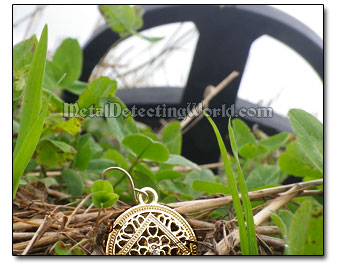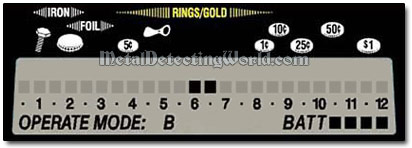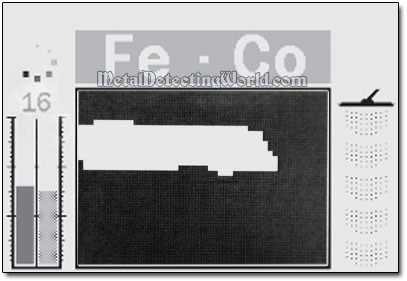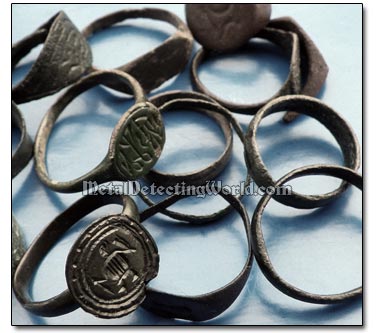Metal Detector's Mode of Discrimination
Beneficial Use of Ample Discrimination, page 3

Here are a few cases when increasing Discrimination, on the contrary, leads to better search results:
1) Highly adverse soil conditions often require a considerable reduction of Sensitivity to eliminate target masking effects of ground minerals. But not all metal detectors are able to compensate the highly intense nonconductive soil even when the Sensitivity is reduced to a reasonable level, and the Ground Balance is properly adjusted (with a POSITIVE OFFSET). In this case, the Discrimination level is slightly increased (i.e. to reduce Sensitivity a bit more) to eliminate ground falsing.
2) Searching for specific target(s), such as a recently lost jewelry item (gold ring, gold earring, etc.), other small personal item, or coins of a particular type, does not require an "open" Discrimination scale since you know the sought target's Conductive (or Ferrous-Conductive) read-outs obtained through an Air Test (Bench Test) and could reject the rest of the scale using Notch Discrimination (see the first picture below). If the search area has low mineral content and is not littered with trash, you can use a lot of Discrimination and still meet the objectives.
Here are two examples of "aggressive" Discrimination:
A. Almost entire VDI scale (1-Dimensional Discrimination scale) of the metal detector is rejected (only two VDI points - "6" and "6.5", are accepted (black)) to find a gold ring that has been recently lost.
Heavy Discrimination on 1-Dimensional Discrimination Scale

NOTE: Be careful using the Notch Discrimination if you use a cheap metal detector which has the notch-discriminator filter of low efficiency, i.e. the rejecting notch does not have "sharp edges". In other words, these edges are rather blurry so that the notch is wider than it is supposed to be, and if the VDI number of a desirable target "lands" into the "plume" of the rejecting notch, the detector's sensitivity to this target will be impaired. You will hear a short and broken response or just nulling of Threshold. And, as result, the target is passed up.
B. Only a small area is accepted (white) on the Minelab E-Trac's 2-Dimentional Discrimination scale - Smartfind window (Smartfind 2 on CTX 3030) to find specific silver hammered coins at the iron-infested site of the former Medieval settlement.
"Aggressive" Discrimination on 2-Dimensional (Ferrous-Conductive) Discrimination Scale

3) If you encounter many identical junk targets such as, for example, brass casings (spent gun shells) at the hunt site, you may reject a short range of their corresponding TIDs, including the TIDs of deformed pieces, on the Discrimination scale. Just make sure that you do not accidentally reject responses to the sought targets.
NOTE: To avoid negative effects of discriminating iron, one should be very careful while using this "modus operandi" in situations that involve abundant FERROUS junk targets.
4) If the current ratio of "dug junk targets to dug good targets" is not in favor of the good targets, and the actual trash is so abundant that your metal detecting time efficiency is dramatically reduced, you may want to use Discrimination rejecting ALL IRON. If you use a FBS metal detector, you may want to include additional Secondary Discrimination Zones corresponding to Hot Rocks and iron falsing caused by the "Wrap Around Effect" into a Discrimination pattern.
Increasing Discrimination will allow you to spend less time learning the site and locate its most productive spots, or simply spend more time on searching for desirable targets. As you gradually deplete the site of all non-ferrous signals and of most large-sized iron targets, switch to a search program with less Discrimination, or simply reduce the Discriminate level. Continue to do so until you do not get any responses to good targets positioned within your detector's operating depth range. If you are a Minelab CTX 3030 or E-Trac user, you may want to check my 3-Level Search Program designed for the above-described situation.
If you can not detect without Discrimination, always remember a simple principle of using Discrimination: the amount of Discrimination to be utilized for detecting desirable targets under current conditions should be considered based on what you would like to find rather than what should be rejected.
Late Medieval Rings

Make a Donation
Please help me stay afloat, afford more metal detecting trips with field-tests and experiments to create more informative articles, useful tutorials and helpful guides for detectorists, and maintain this website - the most informative hobby resource on the web! Since I do not have any steady income, any donation matters to me a lot! Thank you kindly!
Clicking on the donate button will take you to a donation page powered by Donorbox and dedicated to my website (MetalDetectingWorld.com). The donation page is PCI-compliant, secured by SSL/TLS, and has a simple form to fill out. Donorbox does not store any card or bank data. Credit card information is encrypted and tokenized by the Stripe payment processor.
This website would not exist without the advertisements we display and your kind donations. If you are unable to support us by viewing our advertisements, please consider making a Donation to ensure the future of this website. By helping me keep this website alive and growing, you will sure help many detectorists around the world as well!
ANNOUNCEMENT:
In January of 2020, I started a one-time fund-raising campaign in attempt to accumulate enough money to buy a simple but reliable 4x4 vehicle. My old 4x4 car (made in 1995) had faithfully served me for 10 years before it eventually went beyond repair last October. Without a 4WD, I will not be able to get to my hunt sites and test-plots hidden in the remote wooded areas inaccessible by a regular car.
Unlucky for me, those sites are the only locations available and suitable for my field-work which results in informative articles you can find on this website. For the past 10 years, my usual field-work has consisted of field-testing the latest metal detectors and accessories, experimenting with some of them, and devising new effective search methods that meet the requirements of the new metal detecting reality.
Before my car died, I managed to finish a couple of interesting detector-testing projects which will be covered in my upcoming articles. But other equally important projects that I was working on were not completed and had to be postponed until the Spring 2020. I hope that this fund-raising campaign will help me get a decent 4x4 by then so that I will be able to resume my work and to write more new articles, tutorials and guides based on data gathered through testing and experimentation.
If you find my website useful and would like it to provide more essential info for you and other detectorists worldwide, please consider chipping in $5, $20, $50 or whatever you can afford to keep MetalDetectingWorld.com growing in 2020. I promise you, it will be money well spent. Thank you.
Donate- Please help me promote this article:
If you would like to follow me on Twitter, please press a button:
I have my profile page on
where you can share your thoughts on this article, ask me a question, or place a friend request.I also have my profile pages on Pinterest, LinkedIn, Tumblr, Reddit and Delicious
and my "Metal Detecting World" page on Twitter, Pinterest and Tumblr
I no longer maintain my old Facebook page